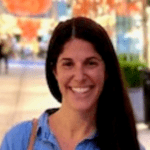
Julia Campbell: Data Driven Storytelling

Julia Campbell returns to share her thinking on retaining and engaging donors by creating and curating your best stories. She’s an author, trainer and speaker. This continues our coverage of the 2023 Nonprofit Technology Conference, hosted by NTEN.
Also this week, we welcome Nonprofit Radio’s first announcer, Kate Martignetti!
Listen to the podcast
Podcast: Play in new window | Download
Get Nonprofit Radio insider alerts!
I love our sponsor!
Donorbox: Powerful fundraising features made refreshingly easy.
We’re the #1 Podcast for Nonprofits, With 13,000+ Weekly Listeners
Board relations. Fundraising. Volunteer management. Prospect research. Legal compliance. Accounting. Finance. Investments. Donor relations. Public relations. Marketing. Technology. Social media.
Every nonprofit struggles with these issues. Big nonprofits hire experts. The other 95% listen to Tony Martignetti Nonprofit Radio. Trusted experts and leading thinkers join me each week to tackle the tough issues. If you have big dreams but a small budget, you have a home at Tony Martignetti Nonprofit Radio.
View Full Transcript
Processed on: 2023-06-25T02:29:31.581Z
S3 bucket containing transcription results: transcript.results
Link to bucket: s3.console.aws.amazon.com/s3/buckets/transcript.results
Path to JSON: 2023…06…646_tony_martignetti_nonprofit_radio_20230626.mp3.830311871.json
Path to text: transcripts/2023/06/646_tony_martignetti_nonprofit_radio_20230626.txt
[00:00:34.88] spk_0:
Hello and welcome to tony-martignetti, non profit radio. Big non profit ideas for the other 95%. I’m your aptly named host of your favorite abdominal podcast. Our announcer, Kate martignetti is gonna stick around last week. I invited her on for fun and I love the way she sounds. So I hired her, Kate. Welcome.
Hello. [00:00:41.36] spk_0:
Glad to have you. Congratulations on your May graduation from American Musical and Dramatic Academy. How did you, how did you find that program? [00:01:14.59] spk_1:
I went to a high school at a technical school for theater and then I just kinda wanted to continue theater as like a professional career. And one of the places that I found during one of those um college fairs where you can let go and speak to other colleges in the area in other states found Amanda. Um and they were like, hey, come work with us, we’re professionals. Everyone has the same passion as you. You will be worked very hard, which is something I really wanted because theater and just being on stage is what I want to do for the rest of my life and [00:01:28.69] spk_0:
where you worked very hard. How did you like, did they work too hard? [00:01:32.49] spk_1:
Yes, they did. They worked me very hard. But I, you know, out in the Real World you’re gonna be auditioning every single day, maybe multiple auditions a day. So I am to throwing us new material every day was honestly really, it helped to prepare us for the Real World. [00:02:02.01] spk_0:
I’m glad you had a great experience at an NDA. And I’m really glad that you are non profit radios announcer. So welcome again, I’d be hit with pseudo AG graphia if I had to write the words you missed this week’s show, [00:02:48.75] spk_1:
data driven storytelling. Julia Campbell returns to share her thinking on retaining and engaging donors by creating and curating your best stories. She’s an author, trainer and speaker. This continues our coverage to the 2023 non profit technology conference hosted by N 10 on Tony’s Take to the gift butter video. We’re sponsored by Donor Box with an intuitive fundraising software from Donor box. Your donors give four times faster helping you help others donor box dot org. Here is data driven storytelling. [00:03:23.73] spk_0:
Welcome back to tony-martignetti, non profit radio coverage of 23 NTC, the 2023 nonprofit technology conference where we are sponsored by Heller consulting, technology strategy and implementation for nonprofits. You can tell that this is much quieter than all the other 23 NTC recordings you’ve heard. That’s because Julia Campbell and I were not able to connect on the floor at the conference, but we’re doing it in follow up. [00:03:26.56] spk_2:
I got the time zones wrong. It’s my fault. All [00:03:34.39] spk_0:
right, Julia, I wouldn’t say it, but yes, Julia messed up the time zones. She was ready two hours after she was supposed to come. I [00:03:38.69] spk_2:
was like, where am I going? What am I doing? And your poor, lovely, you know, associate said, oh, no, that was a while ago. So thanks for bearing with me. [00:04:00.14] spk_0:
Yes, of course. Yes, it’s, it’s Julia Campbell very well, very well worth waiting for. And Julia is an author trainer, speaker and even years ago was the social media manager for tony-martignetti non profit radio which helped launch her author speaker training [00:04:12.55] spk_2:
career. I really, really, really did. That’s so interesting. It was so long ago because it doesn’t seem like that long ago. [00:04:35.35] spk_0:
It was good. 878, 10 years maybe. I’m not sure quite 10, but it’s around there. Yeah, we had, we had fun together. Yeah, we did. Yeah, you always knew what you were doing. You just get me, get me, get me straight. Google. What? Google Mail. What am I like? [00:04:38.03] spk_2:
Yes, you have some, you have some great ideas. But yeah, the technical application, but that’s the perfect example of being in the weeds. And I think you are a great example of knowing your strengths and hiring out and you still do that. It’s inspiring for, you know, entrepreneurs and freelancers like me, [00:04:57.66] spk_0:
I’ve had a social media manager for many uh 15 years, probably 14, roughly 14, 15 years, I’ve had somebody helping me. [00:05:08.51] spk_2:
So nonprofits take note. You don’t have to do it all yourself. [00:05:59.26] spk_0:
Oh, please don’t. Yeah, you don’t, you, you know, based on your scale, you know, you might be able to but if you want to really scale, you know, you need help in a lot of different areas might be grants, it might be social media. Yeah. Don’t, don’t fear the outside folks who can help, you know, they specialize, alright, like Julie, like the Julia Campbell’s, but she’s moved on from being social media manager. Now. She’s author trainer, speaker, August personage generally. So your topic at NTC at NTC? Yes, was retain and engage your donors with data driven storytelling. I feel like we should start with what is data driven storytelling. So let’s start there. [00:08:40.91] spk_2:
Yes. So I think that the term storytelling has taken on this interesting almost jargon e quality where people just sort of throw it around and they say, oh, we have to tell stories or collect stories or share stories. And I’m definitely guilty of a lot of that because a lot of my content and materials and training is around effective storytelling, but a lot of nonprofits don’t work in human services. So there are quite a few of us that maybe don’t have those stories that are incredibly apparent like the puppies and the kittens and the kids and the, you know, the Food Bank. Um So how can we use the data, but also create a narrative around it. So, with storytelling that is data driven, it’s really appealing to people that have that logical mindset. So the way that I taught it and just to go very briefly, the way that I tried to frame it in the session. Okay. Well, the way that I framed it in the session and I did have two other speakers with me that were absolutely fabulous. Um And I want to talk about how they covered it as well, but I talked about Aristotle’s rules of persuasion. So the only way you can persuade someone to take an action is to have three elements. One is logos, which is logic, the logical nature. The second is ethos, which is, which means you need to be credible, which is tony, why you read my bio and talk about my accolades before the podcast even get started because people are automatically saying, why should I listen to her? You know, why should I even pay attention to her? And then there’s pathos which is the emotional connection that you need to have in order to take an action. So data figures into the logos piece of it, which is convincing me that what you’re working on is something that’s urgent and relevant and timely, but also something that’s really a problem like is food and security a problem that sounds silly. When I say it out loud and I’m sure for everyone listening, it sounds silly. But if I ask someone on the street, they might say no, I don’t think so. I don’t know anyone that goes to a food bank. I don’t know anyone that’s food insecure because what we don’t understand, we’re so caught up in the curse of knowledge and what we know that we don’t understand. We still do need to convince people that the problems we’re working on our problems. You know, we can’t just keep sending out fundraising appeals that say everything is great and hunky dory and wonderful because people will read it and say, oh great and just throw it in the trash. We need to incorporate data and statistics into our storytelling to show people that this issue, this cause is relevant and timely and also is really worth our attention, [00:08:55.08] spk_0:
but still make the story humane, [00:10:31.06] spk_2:
but still make the story humane. So storytelling is the way that you’re going to create that empathy that is required. So if the only thing you do is share statistics, you know, and actually I should have pulled up my slides and gotten some statistics because I’m going to just make them up right now. If you say, you know, 100 billion, not 100 billion, 100 million people are refugees right now in Ukraine, right? That’s just a statistic people’s eyes kind of glazed over if you don’t start talking about the story. Like what is the story? Maybe? Tell a story of a family that was displaced, tell a story of a family that came to the United States and what they experienced. So if you read anything that’s good journalism and tony, you know, I studied journalism. Journalism. Journalism is really my passion. That’s why I started my podcast. That’s why I love to write. I love to get the story, but not just the story. I really want to drill down into. Why is this something we need to pay attention to right now? And why is this relevant? And how does this sort of relate to what’s going on in the rest of the world? Because what happens is when non profits do their storytelling, a lot of the time they focus just on their locality or they focus just on maybe even their region if we’re lucky, but we need to tie our stories into the bigger picture of, you know, racial inequality and racial injustice or maybe, you know, the bigger problem of substance use and abuse, the bigger problems of income inequality and how that affects people experiencing homelessness. I think we need to do a better job tying our little piece of the pie into the bigger picture to create that context for our audience. So we shouldn’t rely on data, but we should definitely be incorporating it more, I think with our stories. [00:11:04.62] spk_0:
Alright. This is, it’s, it’s sounding very valuable but a little esoteric. So like how can we or what are there things that we need to think about or I mean, this is not, it’s not a 1234 steps, you know, when you’re done, but how do we approach this so that we can get to what we aspire to human stories that also incorporate data so that people see the bigger context [00:11:33.00] spk_2:
thinking about. So we need to be really creating a system where we’re constantly looking out for not only really effective stories but also data that supports our point that this is a problem. So while I love Humans of New York, I love Humans of New York. Don’t get me wrong. I think it’s, [00:11:49.71] spk_0:
I don’t know if there were more than two volumes, but I have two of those on my [00:12:16.50] spk_2:
book. It is anyone that wants to be a storyteller, especially a storyteller on social media needs to follow Humans of New York on Facebook and Instagram get the books. They’re fantastic, they’re wonderful stories. They make me feel something but Humans of New York, they don’t ask you to do anything. I think they might now be fundraising and there might be a call to action at the end. But in the beginning, it was just sharing these stories to make you, you know, to help you feel like you’re part of the human experience [00:12:22.88] spk_0:
is and compelling photographs of folks [00:12:26.27] spk_2:
exactly compelling [00:12:27.27] spk_0:
visuals and not by a professional photographer. I don’t think he was a professional [00:12:31.36] spk_2:
photographer. No, I think he’s just using an iphone. [00:12:34.07] spk_0:
Yeah. [00:14:54.64] spk_2:
Talk about just something that exploded because as you can see, you know, we’re craving that human connection. So we’re craving like seeing ourselves and other people or you know, we want to be empathetic, we want to be compassionate. But when you want someone to do something, you can’t just share a fantastic story and then say give at the end, it really needs to be what is the impact going to be when you give, for example, what’s going to happen with that donation? A lot of people say give so that 10 people can, you know, have access to the food bank or give so 40 kids can get the backpack, something like that. Yeah. So I consider that a piece of data. So data doesn’t have to be a statistic on the problem. It really just has to be something that is going to appeal to the logical side of my brain. So you’ve got me emotionally, you grabbed my attention, you piqued my curiosity, you pulled at my heartstrings, maybe or you inspired me, maybe you made me angry. That’s a valid emotion to elicit with storytelling. And what are you going to do with that energy? And that’s where a lot of organizations I think get lost. They focus on telling this great story, pulling the heartstrings, but then what happens after or they tell these great stories and they keep telling them, but I’m a donor and I now want to know what is the effect, what is the impact? Like? Tell me great stories. Fine. But if I’m an active donor to organ is a, I’m a monthly donor, I really now want to know how many people have been served this year. How much is this affected? What’s going on? Is it pushing the needle on this problem? Is there legislation being passed? Like what is the sort of what is the impact? And I think that’s lacking and a lot of donor communications because we focus so much on donor acquisition and we don’t focus on donor retention. And when I designed this training, it was really retaining and engaging donors. It was not about donor acquisition. There’s enough data on that. I talk enough about that. But how do we really get them invested by using the statistics and communicating the impact? I think we just continually tell them these great heartstring pulling stories. But at the end of the day, we really want to know a little bit about what was done with the funds that we provided. [00:15:59.12] spk_1:
It’s time for a break donor box. It’s the fundraising engine of choice for 50,000 organizations from 96 countries. It’s powerful enough to double donations and simple enough to be used by everyone. Black girls code increased donations by 400% upward. Scholars increase donations by 270% Maya’s hope saw a 100% increase in donors. The donor box donation forum is four times faster. Checkout, no set up fees, no monthly fees, no contract and 50,000 or go all over the world. Donor box helping you help others. Donor box dot org. Now back to data driven storytelling. [00:16:59.72] spk_0:
The whole point of this is retention and engagement. Alright. So data for, for context data for so for understanding the scope of the problem, you know, sort of human storytelling to pull us in and, and ground it because you’re right, we can’t, we can’t understand something on a scale of 100 million people. It’s not that many in Ukraine, but whatever it is, we can’t understand even a million, even even 10,000 people is hard to understand, let alone millions, right. So, all right. So you know grounding in in one or two concrete stories, um data for impact. So you know what, what, what are we doing? Yeah, the problem is enormous. What’s our part of it? How can you be allied with us, help us alleviate the hunger problem or the domestic violence problem or in our community? Okay. Okay. [00:17:07.59] spk_2:
These are huge problems and it takes the story to contextualize it, but the data to put it in perspective, [00:17:25.56] spk_0:
write the story. Yes, the story contextualized data for perspective and, and context. Exactly. Alright. Alright. Um Right. Without too much reliance on data but but the numbers are important to, you know, get a sense of the scope of the problem. Like you said, I’m just, I’m just reiterating the smart points you, you, you already made. Um [00:19:26.76] spk_2:
And I think another thing that nonprofits trouble with and you probably see this too in your work with like planned giving. Don’t donors, I don’t want to say not all donors are created equal because I hate that saying, but I don’t know how else to say it. Like donors don’t all want the same information. You know, donors don’t necessarily all want the same information depending on where they are in the donor journey. And they might, you know, they definitely need to hear the stories, the success stories, the testimonials, they need to hear the good things that are being done, but they also really need to understand that these problems are not going away. Like you give a $10,000 gift, you’re amazing and wonderful and that’s incredible. And thank you. And here are ways that you can get even more involved or becoming a go to resource on the issue. That’s always what I like to think. People start out the conversation trying to be the go to resource, but they should be, you know, kind of wining and dining the donor. Once they get the money, then they become the go to trusted go to resource on this issue. And they almost become like an advisor telling people you really care about arts in our community. This is what’s going on. You know, this is what the data showing arts is a fantastic way to improve academic excellence or are, you know, we have shown that the kids in our program are getting into college at higher rates, whatever it might be, we throw all that data at people that don’t even know us and don’t even care necessarily care about us. And we don’t end up giving this information to the donor who has raised their hand and put their credit card down and said I care about this issue. Um I think we just focus so much on donor acquisition and throwing so much information at brand new prospects, but not enough using this data to cultivate and retain existing donors [00:19:56.58] spk_0:
and motivate. Um you know, you want folks to feel good about whether it’s $10,000 or $1000.50 dollars, you want them to feel good about what they’ve done. So they’re encouraged to, to do the same or more and not leave and not be among the, was it 75% of first year donors leave us? [00:20:05.48] spk_2:
I think the fundraising effectiveness project data that just came out something like 80% of first time donors leave and then overall donor retention is around 46%. [00:20:32.87] spk_0:
Yeah, not even half right, not even keeping half half our donors. Yeah. Alright. Alright. So smart to focus on retention engagement. Um What else? What else what else did you talk about? Because you had the other, you have the uh co presenters. So I don’t want to specifically ask you things that were in the like the learning objectives. And then you say, well, that was somebody else’s support [00:23:41.34] spk_2:
so well, we really worked collaboratively together. So, um my two co presenters, one was Patrick Byrne, who’s the CEO of the Challenge Foundation, which is an organization based in Denver. And then Candice Cody, who’s been a longtime friend of mine, but she does marketing and data analysis for community boost, which is a consulting firm. So I asked Patrick to join us because he has that for, you know, um in the trenches perspective, he had just actually changed jobs, but he’s been working in um education and after school and youth development for decades in Denver is actually pretty well known. So, and he’s the CEO, he goes out and does a lot of these donor meetings, which we’re all very familiar with. So he’s one of those CEO that loves to go meet with donors, loves to talk, loves to present, loves to be like on the forefront of the issue. And he says that he Jen, he generally like will with a major donor lead with the data almost. It’s not like they’re parading around, you know, he doesn’t usually have one of the youth um come with him to these meetings, first of all, because of confidentiality and ethic, ethical reasons. Certainly they have events where the donors get to see the program in action. But he says often what he finds with the big big donors in the foundation certainly is that they want to see that data. So they understand that the problem is, you know, it’s really large and they know the success stories because the Challenge Foundation has done a great job in terms of marketing and pr and they’re always in the news, but they want to see kind of the hard facts. Like are we really pushing the needle on this? Like, are we really getting good results? Are we getting the bang for our buck if you will? Um What are the outcomes? You know, what are, what’s the actual impact based on our goals and objectives of what we’re trying to achieve? So he was talking a lot about his experience, talking to donors, his experience collecting those human interest stories as personal stories, how they do it at his organization. They have a whole system, they train their employees in storytelling, all of them so that they can notice a good story or a mission moment or a little quote or a testimonial when it comes up so that they always have like a database of stories to pull from. So when I tell clients that they, that really freaked out because they don’t want they, they think that it’s going to be everybody out in the wild West posting all over Instagram without any guidelines, but that’s not what it is. It’s really just people collecting the stories and sending it back to one person who’s kind of the gatekeeper and figures out the permissions and things like [00:23:43.42] spk_0:
that. That’s valuable. You’re curating stories throughout the organization. Yes. [00:24:40.43] spk_2:
And really, that’s the only way that storytelling is gonna work if you have it infused into the culture, if you just have your development director and I’ve been that development director that is the only person responsible for stories. What’s going to happen as I used to do every Friday, I would send out an email and say, hey, everybody, I’m gonna send out the newsletter this week or I’m sending out donor. Thank you. I really need a great story. And then of course it’s crickets. So if it’s not infused into the culture and if it doesn’t come from the top down, the importance of collecting these kinds of things, it’s just not going to happen. I mean, people are so busy, think about all of the things like anyone listening, think about all the things on your plate right now. But if it’s part of your job description, you know, part of your expectation. And if it’s just something that’s part of the culture of the organization, it makes it a lot easier. Yeah. And it [00:24:41.46] spk_0:
makes it easier for the for the person who does have to curate the content because there’s this library of, of valuable stories that you can go back and ask more detail about. But, you know, like, well, you know, this, we have this great success or this, this woman gave said something about our work and here’s, you know, here’s what she said. [00:25:09.61] spk_2:
Exactly. And you, you can’t always be on the front lines. In fact, you’re probably not always on the front lines, the marketing person, the fundraising person, and you’re not gonna [00:25:10.53] spk_0:
remember it, You know, six weeks later when the, when the newsletter person emails you, you know, because it happened six weeks ago, you’re not gonna remember that story, but in real time. All right, that’s valuable in real time. If people just have somebody to email, look, there’s great, great quote from this woman. You know, I can tell you more if, if you decide [00:27:41.51] spk_2:
exactly, I can tell you more or I had lunch with this donor and I think she’d be really perfect for our gala. Just make a mental note. You know what I mean? And it’s things you can follow up on later. And what I always say is that these stories are evergreen. People think that email and social media, everything has to be something that you came up with that second. It really doesn’t like if it’s a story from five years ago, it’s still powerful and no one knows it was from five years ago and it’s still like it still has that impact. I just think we overthink the content creation and the storytelling, the story gathering process because we think it has to be something that happened this week. It really does not. Like sometimes people work on stories for months, you know, they work on them for weeks. Like thinking about making a video, you can work on that for a really long time. It doesn’t have to be this like, oh, this person told me this story today and I have to post it today. That’s the way I think we think about things, think about websites that have stories on them that are really God only knows how long the stories have been on there. But that doesn’t diminish their impact. It doesn’t diminish the person’s transformation or the life that was changed or the impact that was made. It just, it just um you know, if you have that, that powerful like evergreen story that never goes stale, you can build on it and why not revisit stories? That’s another whole topic. Charity Water does that they constantly are revisiting people that they told stories about and sharing new information about these people. And I just wonder why we have to constantly be on this hamster wheel of storytelling and we don’t dive a little bit deeper or maybe, you know, revisit someone that was in our program that we talked to, maybe talk to them five years later or even just a few months later. So the constant content creation, hamster wheel and the view of storytelling is it has to be this perfectly crafted Lord of the Rings trilogy kind of thing where there’s, you know, the hero’s journey drives me crazy journey. [00:27:47.80] spk_0:
Yeah, the [00:28:21.34] spk_2:
hero’s journey. It’s the, it’s the one we all know. It’s like the Luke Skywalker, the Harry Potter Frodo. I mean, it’s the, the Hunger Games, you know, Katniss, it’s the reluctant hero and then the guide and then we all know that story. But when we are talking about storytelling, especially on digital channels, it really can just be a great picture and a quote like Humans of New York does it or it can be a mission moment or it can be a piece of data and then illustrating that data with a quote with a testimonial. So I think we tend to think everything has to be perfect and very produced. But on the other hand, that’s stopping us from doing the work, I think it’s a little bit of an excuse. Honestly, [00:28:36.25] spk_1:
it’s time for Tony’s take two. [00:29:13.33] spk_0:
You can watch the video of last week’s webinar that I did with Give Butter. It’s debunk the top five myths of Planned Giving. I was with Floyd Jones from Give Butter. And when I say with, I mean, we were sitting next to each other, it was terrific. What I’ve never done a webinar like that and I hope I can do more where we’re sitting side by side. So we joined each other’s screens and we just, we had a good time at, at the, we were in Brooklyn. So if you want to watch the video of debunked, the top five myths of Planned Giving the video is on the Butter blog at give butter dot com. [00:29:23.98] spk_1:
That is Tony’s take to, we’ve got just about a butt load. More time for data driven storytelling with Julia Campbell. [00:29:53.07] spk_0:
That’s all very valuable. Go back, you know, like if you’re listening, I would go back 10 minutes and replay what, what Julia just said because there’s 44 valuable points in there that will help your storytelling, help your content curation really valuable. Um And what did you just say that something is hurting us? What was the last thing like last sentence you said? [00:30:00.97] spk_2:
I think it’s a little bit of an X. It’s [00:30:03.11] spk_0:
an excuse. Yes, it’s an excuse. So not happening because we don’t have anything that’s 24 hours recent. [00:31:12.51] spk_2:
So or we don’t, we don’t have the budget to make produced video. I could tell you every excuse in the book, every storytelling excuse I have been told and there are ways around it and this is not my quote and I just wrote it down for a talk that I’m doing and I can’t, I want to give credit to somebody for it, but it doesn’t take resources to be resourceful and you have to consider, you know, your budget, your band with your capacity and also, of course, there’s ethical considerations around storytelling, but none of this is insurmountable. I’ve worked with organizations. I work with an organization that focuses on their think tank and they focus on chronic absenteeism in the United States. They never tell stories about students because they don’t want to focus on a student who’s chronically absent. I think that would be highly unethical to do that. And also it’s, you know, there’s such a stigma around it that it’s hard to find personal stories for them, but they still managed to talk to teachers or principals or even other um like legislators about their work. I mean, there’s ways to do it without getting that. You know, Julia was hungry and she came to the shelter and we helped her. [00:31:27.96] spk_0:
But can’t they tell a story of a student just anonymized? [00:31:37.21] spk_2:
They could they tell they interview a lot of teachers who tell stories, the third party stories, okay. But because they don’t provide direct services so they provide training and assistance and legislative advocacy. I mean, their think tank, [00:31:54.70] spk_0:
right? But let’s, let’s take, let’s take a hypothetical then playing off that. I mean, if you, if you do do direct service work, the stories can be anonymized, right? Not to use the neighborhood that they live in, you can pick another neighborhood. You don’t have to use their age, you can pick something different than their age. You don’t have to use their name, you can pick a fake name. No, the, but the story can still be told that that sounds like a, that sounds like one of your excuses. We don’t want to, I don’t want to compromise. We have ethical and maybe even legal [00:33:49.15] spk_2:
requirements. Okay. So anonymized of confidentiality clients I’ve worked with one is called Plumber Youth Promise their foster care agency and Salem Mass, they only work with underage kids because once they turn 18, they age out of the foster care system. So they sent an email out the other day that I saved because I wanted to use it as an example um with my clients and it said that 40% now this is like such a horrifying statistic. 40% of kids that age out of foster care, like our homeless instantly just homeless because they don’t, they’re not staying in their foster care family. Maybe they can stay in their foster care families house. Um They certainly can’t stay in the facility because of laws, state law. Oh my God, it’s so horrible. So that is such an example of that statistic grabbed me and then they told a story of girl that they assisted um while she was transitioning out and they talked about their whole transitioning program and what they do when kids turn 17 and how they work with them for a year to figure out this transition. So they don’t turn homeless. It was really amazing and like it was just super I opening for me because I guess we all, I don’t know, I just never thought of it that way, but it was using data in this way to kind of open my eyes. But then sharing a story of how okay this this piece of data is horrible, but here’s what we’re doing, you know, in our little corner of the world to combat it. And it was, it was all anonymized. Like you said, there was a picture of like a tree in the email and it was, the story was, you know, obviously names changed and everything. So there’s definitely a way, there’s ways to do it. [00:34:28.71] spk_0:
All right. Thank you. Encouragement, encouragement. They always, this is, this goes to something I’ve, I’ve said on the show a few times and I say in my trainings too often, you know, I like to think about how we can instead of why we can’t, if you’re looking for the, why we can’t. You come up with 1000 reasons were under resourced. We’re, we’re understaffed. It’s a holiday [00:34:29.83] spk_2:
week. It’s a recession. It’s this, it’s that it’s a political campaign [00:34:34.80] spk_0:
has time, right? It’s the summer. It’s the fall, it’s the winter. It’s the spring, nothing can get done in those four seasons. No, we need a new season. You know, exactly why you can’t. But the, how you can focus on the, how you can see why you can’t, how could we get it done. Let’s assume we’re gonna do it. How can we do it? How can we do it? [00:35:36.64] spk_2:
I love that. I think it’s all about framing and a lot of it is mindset like you and I both teach tools and tactics. But if you have a person, what you just said is so interesting is if you have a person that comes to you for training and help, but they are just thinking about, they want you to just legitimize why they can’t do something. I immediately say, I just don’t think this is gonna work until we can get into that. What can we do space? Because especially with storytelling, people do, they have a lot of challenges that are very valid and then they have some challenges that maybe they could work on that. They put up these walls that they think. Well, we can’t share this, we can’t collect this data, we can collect this story. So coming at it from that we can, I think I’m guilty of doing that in my own life. I think you’ve just inspired me to change my own thinking. Sometimes I’ve got to come at it as a I can like, what can I do? I can’t do that. Okay. What can I do? [00:36:11.90] spk_0:
Exactly. Exactly. Alright. Any more encouragement on data, the intersection of data and humanity, let’s say [00:37:43.52] spk_2:
data and humanity. Well, I believe that we do so much data collection and we have absolutely no idea of what we’re doing with it? So with any kind of data collection that you do, whether it’s internal or external or social media or its program related, always have a focal point. How is this going to be used? How are we going to improve what we’re doing? How you know, what could this inspire? What could this elicit, what minds could be changed? What behaviors could be changed? Always have that sort of bigger picture view of the data you’re collecting. Because if you know, we can all collect data all day, every day, but if we’re not using it in an effective way, if we’re not contextualizing it for people or if it’s just a piece of data that we’re not doing anything with, it’s really not going to be worth anything. And I also really encourage people have empathy for your audience. So this is something that J Kenzo says he’s one of my favorite authors and podcasters, J A Kenzo and he says have empathy for your audience, make everything very explicit, very clear, very short, don’t wrap a ton of stuff in 90,000 statistics and flow charts and things like that. Unless it’s a funder, you know, you’ve gotta know your audience. But if you’re thinking of an email or social media post, just have empathy for people, they’re scrolling, they’re busy, they have 90 1000 other emails, their boss is yelling at them, their kids are probably homesick, you know, whatever it is. Just make sure that you are providing the most relevant information, something that’s going to help them inspire them, something that’s going to encourage them to take the action that they want to take, [00:38:02.73] spk_0:
have empathy for folks. Channel, channel your folks. I try to channel our listeners when I’m talking to smart folks like you. All right. [00:38:11.95] spk_2:
Yes, I love that. Be your audience. Think about your audience first, [00:38:16.04] spk_0:
Julia Campbell August personage [00:38:20.42] spk_2:
personage. Uh going to put that in my email signature. [00:38:33.66] spk_0:
Uh But more more uh perfunctorily, she’s author, trainer and speaker and was a speaker at 23 NTC. Thanks to [00:38:37.57] spk_2:
excellent [00:38:39.63] spk_0:
my pleasure and thank you for being with the ever continuing coverage of 23 NTC. Even four weeks later, still still capturing the smart speakers. And we were sponsored at 23 NTC by Heller consulting, technology strategy and implementation for nonprofits. Thanks for being with us [00:39:42.29] spk_1:
next week, 10 fundraising boosts on a budget and personalized fundraising at a scale. If you missed any part of this week’s show, we beseech you find it at tony martignetti dot com were sponsored by Donor box with intuitive fundraising software from donor box. Your donors give four times faster helping you help others. Donor box dot org. Our creative producer is Claire Meyerhoff. I am your announcer Kate martignetti. The shows social media is by Susan Chavez, Mark Silverman is our web guy and this music is by Scott Stein. [00:39:48.78] spk_0:
Thank you for that affirmation. Scotty B with me next week for nonprofit radio, big nonprofit ideas for the other 95% go out and be great.

 If you have folks spanning the generations working or volunteering for your nonprofit, you may have noticed they learn technology differently. Lauren Hopkins shares the strategies for teaching tech across the generations. She’s from
If you have folks spanning the generations working or volunteering for your nonprofit, you may have noticed they learn technology differently. Lauren Hopkins shares the strategies for teaching tech across the generations. She’s from 





 Widespread data literacy helps your teams build a shared language of data communication, recognize good and bad data, and appropriately apply analytics to improve decision making. Alexandra Mannerings makes the case. She’s from
Widespread data literacy helps your teams build a shared language of data communication, recognize good and bad data, and appropriately apply analytics to improve decision making. Alexandra Mannerings makes the case. She’s from